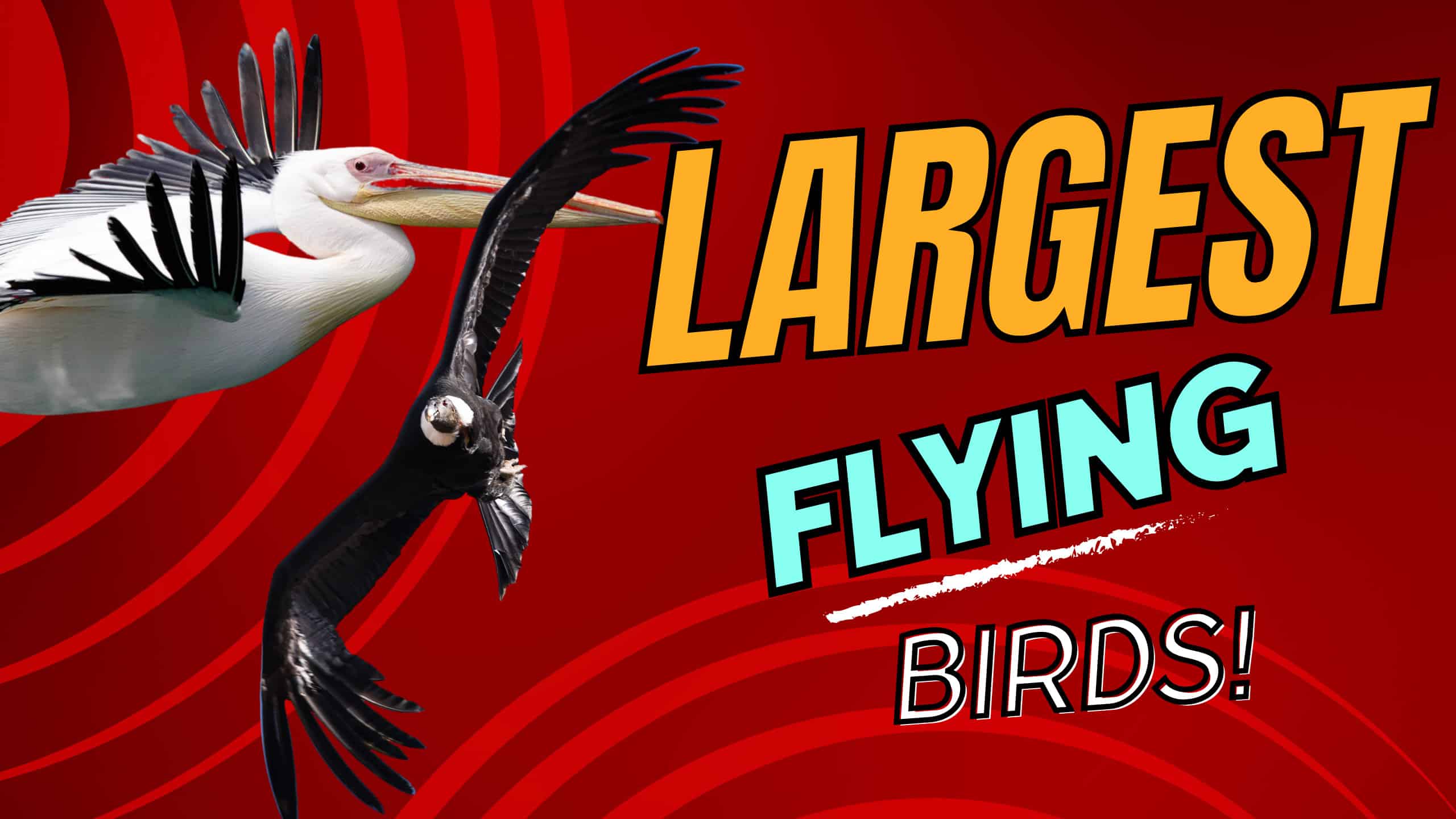There are over 10,000 species of birds in the world. Some, like the bumblebee hummingbird, are very small. Others, like the common ostrich, do not fly. What is the largest bird in the world? If you consider birds that fly, then these are the largest birds in the world by wingspan.

9. Marabou Stork – 10-foot Wingspan
The Marabou stork, sometimes called the undertaker bird, lives in wet and arid areas south of the Saharan Desert. This bird that typically lives near landfills weighs up to 17 pounds. This black bird looks like it is wearing white underpants, especially when viewed from the rear.
There are isolated reports of birds with wingspans up to 13 feet. These birds reach sexual maturity when they are about four years old, and they mate for life. They are scavengers who can often live near human settlements.
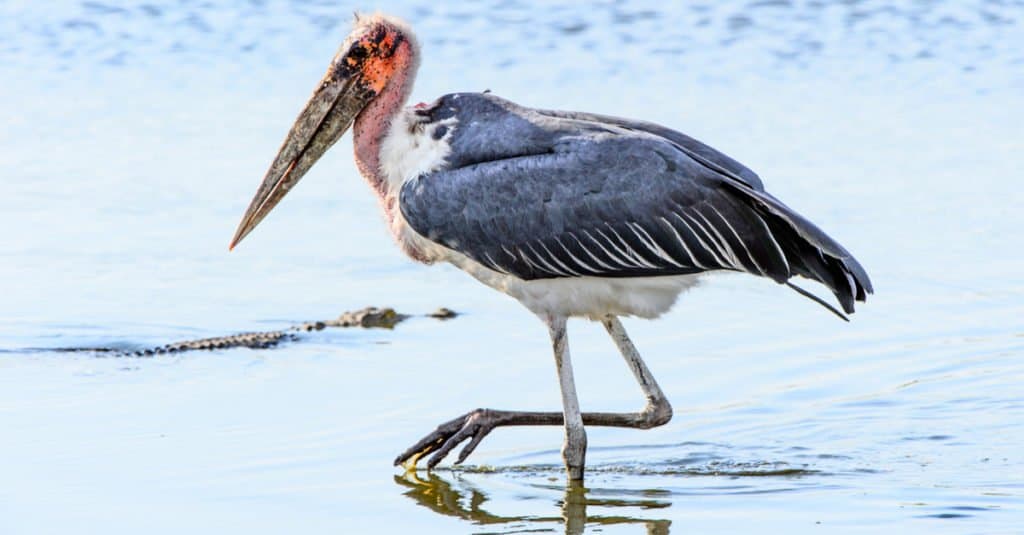
©Anton_Ivanov/Shutterstock.com
In captivity, these storks can live up to 20 years, although, the lifespan while in the wild is unknown. Marabou Storks have hollow leg and toe bones. For this reason, this type of bone structure is vital for flight. Furthermore, the pouches on their throats are not used for food storage like some other birds. Their large throat sacks are used for attracting a mate.
8. Northern Royal Albatross – 10-foot Wingspan

©iStock.com/AGAMI stock
Also referred to as the toroa, the northern royal albatross has a wingspan of 10 feet. Slightly smaller than its southern cousin, this seabird can be recognized by its wings which have a mostly dark, upper surface.
This endangered bird lives on New Zealand’s Chatham Islands, Taiaroa Head, and South Island. While there is still reason for concern, the number of these birds is steadily increasing.

©Nokuro/Shutterstock.com
This is thanks in no small part to conservation efforts which make nesting easier and safer. They include a sprinkler system on their favorite nesting site at Taiaroa Head to stave off heat sensitivity on hot days. They also include the placing of handy cotton balls drenched in peppermint essence in nests (by conscientious staff) to mask the smell of albatross eggs in order to prevent flystrike.
This bird weighs about 16 pounds and does not mate until it is eight years old. That said, it is relatively long-lived and can live for up to 40 years. It feeds on fish that are dead or dying near the surface of the water.
These birds perform elaborate mating rituals on the water and in the air. They build large nests using plant materials on the shoreline. Both the male and the female help to incubate the eggs and raise the young.
7. Andean Condor – 11-foot Wingspan
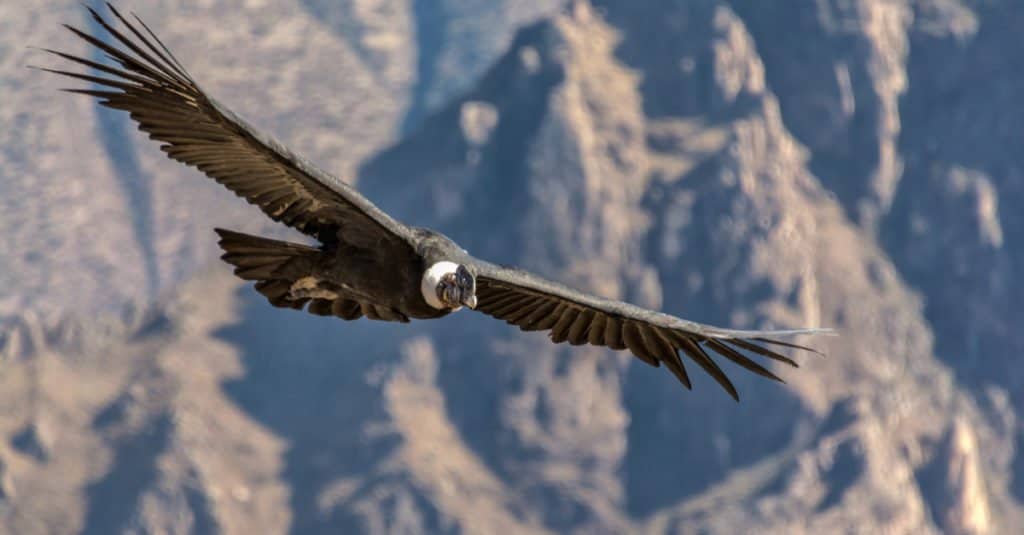
©Gus Martinie/Shutterstock.com
The Andean condor lives in the Andes mountains. It is the national symbol of Bolivia, Chile, Colombia, Ecuador, and Peru. This bird which weighs about 29 pounds is listed as vulnerable. Once this bird is air-bound, it seldom flaps its wings but soars through the air. This black bird with a bit of white on it can live to be 50 years old. It reaches sexual maturity at about six and mates for life.
This scavenger bird is the only one to show sexual dimorphism. Males have a large red comb on the crest of their heads. They have no syrinx, so they cannot vocalize. When they are feeding near a vessel, you may hear them make clucking or hissing sounds.
6. Antipodean Albatross -11-foot Wingspan

©Imogen Warren/Shutterstock.com
One of the largest flying birds by wingspan, the Antipodean albatross is a South Pacific endangered bird. While you can see it in many locations, all return to New Zealand’s Auckland Islands, Antipodes Islands, and Campbell Island to breed. This bird can weigh up to 19 pounds. It has an 11-foot wingspan.
This bird only lays eggs every two years, with each returning to the area where it was born to lay its eggs. These birds do not become independent until they are about 250 days old and do not become sexually mature until they are seven years old. Both males and females share responsibility for incubating the eggs and raising the young.
5. Tristan Albatross -11-foot Wingspan

©Agami Photo Agency/Shutterstock.com
The Tristan albatross lives in the South Atlantic Ocean. Its 11-foot wingspan helps it forage over a lot of territories. It breeds almost entirely on Gough Island. Females feed east of the island, where you can see all the way to South Africa, while males forage west of the island, where you can see them all the way to South America.
These critically endangered birds only breed every other year, and they mate for life. The adult birds return in November to the island. Females lay their eggs in open heath where there is plenty of room to soar when taking off. Once hatched, chicks do not leave the nesting area until November. This bird does not become sexually mature until it is 10 years old.
4. Dalmatian Pelican-12-foot Wingspan

©Ondrej Prosicky/Shutterstock.com
The Dalmatian pelican is a native of Mongolia, but most live in Russia. You can also find this species living in freshwater lakes and wet habitats near the Mediterranean coastline. This bird has a 12-foot wingspan and is the largest member of the pelican family. It can weigh up to 33 pounds. Most of this pelican’s diet is fish.
This near-threatened species has a disheveled off-white appearance. It has one of the largest beaks of the pelican family. The beak is a dull yellow most of the year, but it turns bright orange during mating season. It flies in flocks with its neck held back like a heron.
3. Southern Royal Albatross- 12-foot Wingspan
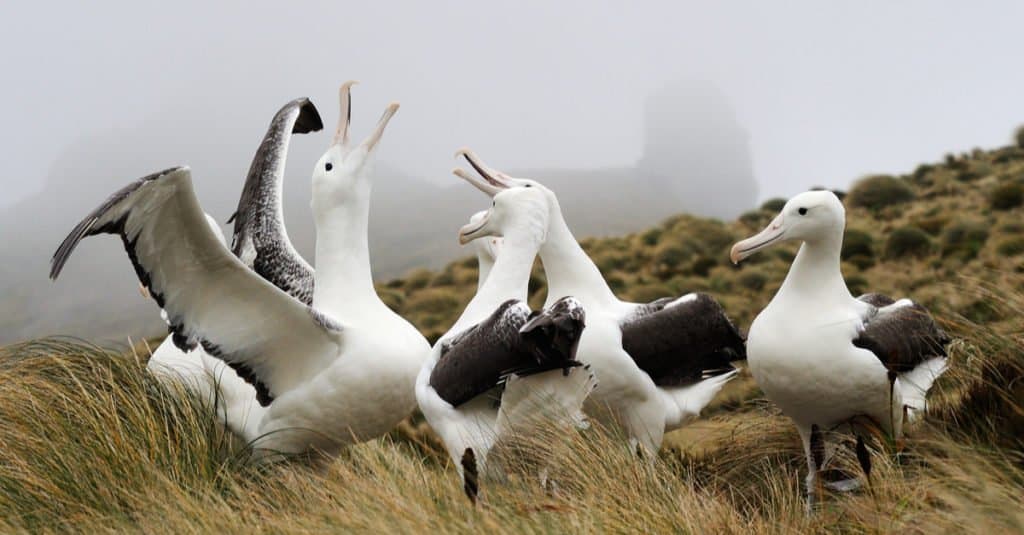
©AndreAnita/Shutterstock.com
The Southern royal albatross has a wingspan of 12 feet making it one of the largest flying birds by wingspan. It lives mainly in South American waters, but most return to subantarctic Campbell Island when it is time to lay their eggs. To move from South America to the Campbell Islands, they circumnavigate the globe. They eat a diet of fish caught from the water’s surface or slightly below.
Southern royal albatrosses usually breed for life, but some have split up. Females lay one-to-two eggs in November, which hatch in January. The male and female take turns caring for the young until the following November.
2. Great White Pelican – 12-foot Wingspan
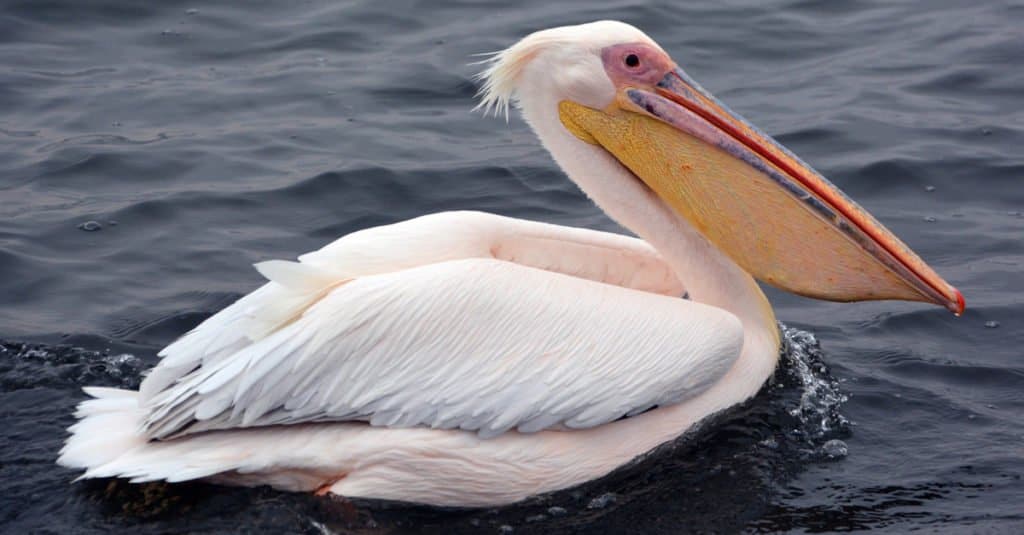
©meunierd/Shutterstock.com
The great white pelican with its massive 12-foot wingspan is the runner-up on this list of the biggest bird in the world in terms of wingspan. This bird lives in swamps and shallow lakes from southeastern Europe through Asia and Africa. Males can weigh up to 33 pounds, while females weigh up to 20 pounds. Breeding takes place mainly in South Africa but can also occur in Russia, Turkey, and Northern Greece.
This bird is a very social animal that feeds in groups of six to eight. The birds will form a circle around a school of fish and dip their beaks in unison. Then, when they lift their head and the pouch in their beaks force out the water, leaving them with a delicious mouthful of fish. Their diet, however, is not restricted to marine life. They can also be foragers who often eat the chicks of other bird species.
The world is full of amazing birds with large wingspans. Learn about them and get involved in the efforts to protect their habitat.
1. Wandering Albatross – 12.1 foot wingspan
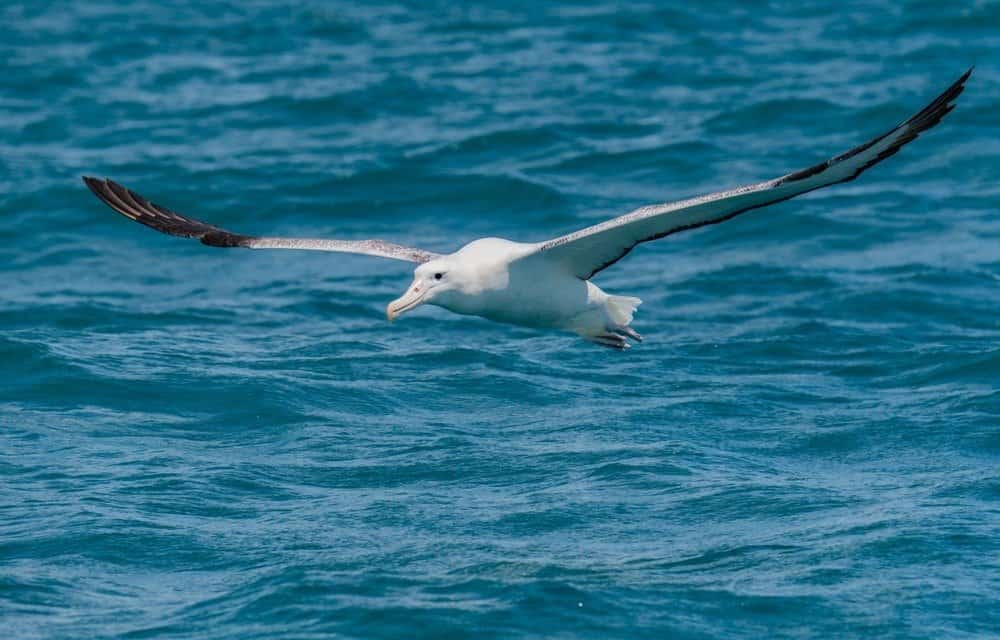
©Kerry Hargrove/Shutterstock.com
Introducing the largest bird in the world in terms of its wingspan. The Wandering Albatross (maximum verified wingspan of 3.7 meters / 12.1 feet) narrowly beats out the Great White Pelican (maximum wingspan of 3.6 meters / 11.8 feet) on average by a few inches of wingspan.
The wandering albatross lives mostly on the wing above the world’s southern seas. As one of the largest birds living, it has been the subject of numerous studies. As a result, researchers have compiled an extensive list of facts about the species. Although the average wingspan of the wandering albatross is about 10 feet from wingtip to wingtip, unverified accounts report measurements up to 17 feet, 5 inches.
These majestic birds can soar for hours without flapping their wings once, and they only stop flying to feed and breed. They travel a staggering distance of 75,000 miles per year, which is like making almost two full trips around the entire planet.
Summary of the 9 Largest Flying Birds by Wingspan
| Rank | Bird | Wingspan |
|---|---|---|
| #1 | Wandering Albatross | 12.1 feet |
| #2 | Great White Pelican | 12 feet |
| #3 | Southern Royal Albatross | 12 feet |
| #4 | Dalmatian Pelican | 12 feet |
| #5 | Tristan Albatross | 11 feet |
| #6 | Antipodean Albatross | 11 feet |
| #7 | Andean Condor | 11 feet |
| #8 | Northern Royal Albatross | 10 feet |
| #9 | Marabou Stork | 10 feet |
Honorable Mention: Other Large Flying Birds by Wingspan
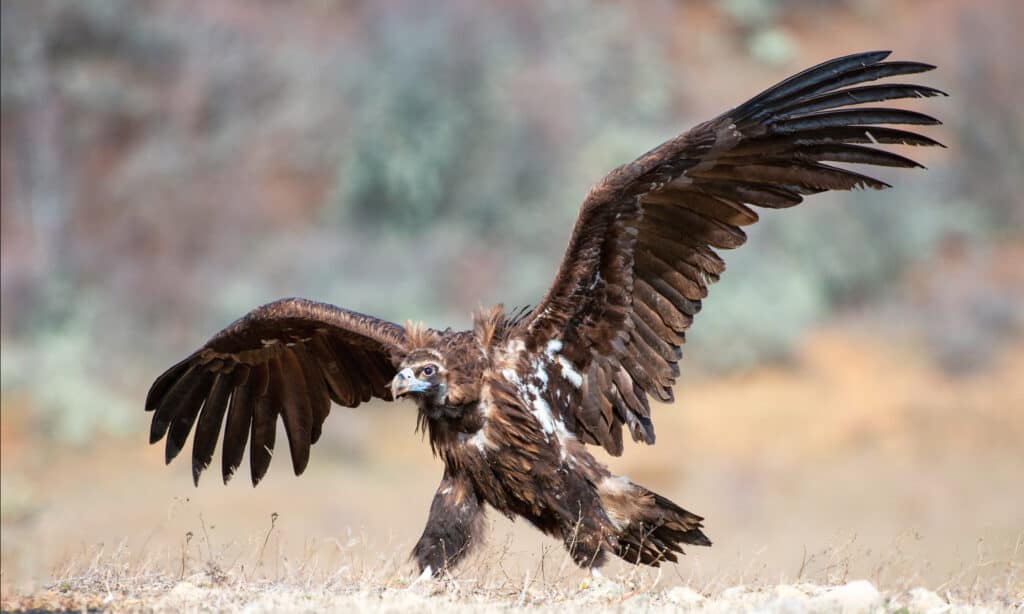
The Cinereous vulture (
Aegypius monachus) is one of the biggest flying birds in the world.
©WildlifeWorld/Shutterstock.com
There are believed to be around 10,000 to 11,000 different bird species throughout the world. Many of these feathered animals may not be in the running for the top large flying birds, like the Ostrich (Struthio camelus). This may be the largest bird in the world, with a wingspan of 66 inches, an average weight of 229 pounds, and a body length of 82.67 inches, but is flightless. Here we look at some additional birds of flight that have impressive wingspans:
- Cinereous vulture (Aegypius monachus) – also known as the black vulture, monk vulture, and Eurasian black vulture. This is a large raptor that belongs to the family Accipitridae and can be found throughout Asia and Europe. The largest raptor in the family, and one of the largest Old World vultures, it has a wingspan of 10 inches, a body length of 3 ft 11 inches, and a weight topping out at 31 pounds. These scavengers have a diet that consists mostly of carrion, which is the remains of dead animals.
- Himalayan vulture (Gyps himalayensis) – also known as Himalayan griffon vulture, this is also one of the largest members of Old World vultures and is endemic to the uplands of central Asia, in the Himalayas, where they may range from Afghanistan and Kazakhstan to western China and Mongolia. This raptor has a wingspan of 10 inches (although some reports have measured slightly larger, and slightly smaller), has a body length that ranges from 37 to 51 inches, and weights that range from 13 to 28 pounds. Unfortunately, it is listed as Near Threatened on the IUCN Red List.
- Trumpeter Swan (Cygnus buccinator) – this is the heaviest native bird found in North America, as well as being the largest extant species of waterfowl. Trumpeter swans have a wingspan of up to 10 inches, body lengths that range from 54 inches to 65 inches (with males at times being slightly longer), and weights ranging from 15 to 30 pounds. They were almost driven to extinction in the early part of the 20th century but thanks to efforts to protect them, they have made a comeback.
- California Condor (Gymnogyps californianus) – this New World vulture is the largest North American land bird and is the only surviving member of the genus Gymnogyps. It was once considered extinct in the wild but has since been successfully reintroduced to the following areas in the United States and Mexico – northern Arizona, the coastal mountains of California, southern Utah, and Baja California. Although it is still currently listed as Critically Endangered by the IUCN Red List. This large vulture has a wingspan of 9.5 inches, has weights that can reach up to 26 pounds, and a body length of 46 to 53 inches.
What Animals Eat Birds?
Birds are a vital part of many different ecosystems, serving as prey for a variety of predators. In this article we covered massive birds with huge wing spans, let’s dive in and discuss the animals that feed these mammals.
Here are animals that prey on birds:
- Raptors: or other birds of prey have been known to cannibalize other birds. They will often hunt together and are known for their hunting abilities.
- Snakes: Many species of snakes feed on birds, particularly smaller species. Snakes use their powerful jaws to swallow birds whole, and some species have developed unique hunting strategies to catch their prey.
- Cats: Domestic cats are one of the most common predators of birds, particularly in urban areas.
- Foxes: Foxes are opportunistic hunters and will eat a variety of prey, including birds.
- Crocodiles: Crocodiles are known to eat birds, particularly those that come close to the water’s edge.
Thank you for reading! Have some feedback for us? Contact the AZ Animals editorial team.

